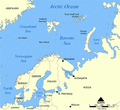Coccolithophores, or coccolithophorids, are single-celled organisms which are part of the phytoplankton, the autotrophic (self-feeding) component of the...
90 KB (9,375 words) - 10:01, 30 August 2024
Braarudosphaera bigelowii (section Coccolithophore)
Braarudosphaera bigelowii is a coastal coccolithophore in the fossil record going back 100 million years to the Late Cretaceous. The family Braarudosphaeraceae...
6 KB (440 words) - 15:46, 26 June 2024
Gephyrocapsa huxleyi, formerly called Emiliania huxleyi, is a species of coccolithophore found in almost all ocean ecosystems from the equator to sub-polar...
26 KB (2,786 words) - 14:20, 14 November 2024
Coccoliths are individual plates or scales of calcium carbonate formed by coccolithophores (single-celled phytoplankton such as Emiliania huxleyi) and cover the...
25 KB (2,538 words) - 20:02, 17 September 2024
(2009). "Cold stress stimulates intracellular calcification by the coccolithophore, Emiliania huxleyi (Haptophyceae) under phosphate-deficient conditions"...
2 KB (204 words) - 04:52, 30 September 2024
spring and Pseudosolenia calcar-avis blooms during the autumn. Coccolithophores Coccolithophores are a type of motile, autotrophic phytoplankton that produce...
117 KB (11,747 words) - 00:41, 22 December 2024
Marine protists (section Coccolithophores)
with two chytrid-like fungal pathogens. Scale bar = 10 μm. Coccolithophores Coccolithophores are minute unicellular photosynthetic protists with two flagella...
133 KB (10,590 words) - 01:51, 21 October 2024
Protist shell (section Coccolithophores)
Coccolithophore shells Many protists have protective shells or tests, usually made from silica (glass) or calcium carbonate (chalk). Protists are a diverse...
41 KB (3,843 words) - 18:33, 13 September 2024
dodecahedral cells Braarudosphaera bigelowii – a dodecahedron shaped coccolithophore (a unicellular phytoplankton algae) Pentakis dodecahedron Roman dodecahedron...
28 KB (2,048 words) - 19:47, 8 December 2024
the front as required to match his mood.[citation needed] The fossil coccolithophore Braarudosphaera bigelowii (see figure), a unicellular coastal phytoplanktonic...
35 KB (3,610 words) - 03:05, 20 December 2024
another scientific phenomenon, the "Cheshire Cat" escape strategy. When Coccolithophore – a species of successful ocean algae – is able to resist the haploid...
35 KB (3,781 words) - 21:05, 12 December 2024
nanometres across. Regular polyhedra appear in biology as well. The coccolithophore Braarudosphaera bigelowii has a regular dodecahedral structure, about...
32 KB (3,126 words) - 21:09, 19 December 2024
cytoplasmic membrane-bound vacuoles. The best-known haptophytes are coccolithophores, which make up 673 of the 762 described haptophyte species, and have...
18 KB (1,517 words) - 16:38, 3 December 2024
organisms in themselves (such as the marine plankters foraminifera and coccolithophores) or component parts (such as small teeth or spores) of larger animals...
111 KB (11,442 words) - 22:08, 30 November 2024
under the sea as the scales or plates of tiny micro-organisms called Coccolithophore. It was the first white pigment used by prehistoric artists in cave...
77 KB (9,183 words) - 01:46, 13 December 2024
False-color scanning electron micrograph of the unicellular coccolithophore Gephyrocapsa oceanica...
89 KB (10,338 words) - 21:51, 21 December 2024
form of the mineral diopside Coccolithophore, a class of phytoplankton (alga) Coccolith, a platelet formed by coccolithophore, found in chalk This disambiguation...
983 bytes (158 words) - 18:22, 1 September 2016
important groups are the diatoms, cyanobacteria, dinoflagellates, and coccolithophores. Zooplankton (from Greek zoon, or animal) are small protozoans or metazoans...
62 KB (6,471 words) - 20:01, 24 November 2024
sulfide is also produced by marine planktonic microorganisms such as the coccolithophores and so is one of the main components responsible for the characteristic...
21 KB (2,082 words) - 02:15, 29 October 2024
semi-precessional timescales. Pleistocene 240 Kya / Indian and Pacific oceans / Coccolithophore in 9 deep sea cores 9 deep cores in the equatorial Indian and Pacific...
191 KB (20,504 words) - 16:11, 12 November 2024
becoming globally distributed in tropical latitudes by the Late Jurassic. Coccolithophores and dinoflagellates, which had first appeared during the Triassic,...
234 KB (25,310 words) - 16:39, 19 December 2024
A true color SeaWiFS image of a coccolithophore phytoplankton bloom off of Alaska...
20 KB (2,458 words) - 08:19, 27 October 2024
consists of coccoliths, microscopically small calcite skeletons of coccolithophores, a type of algae that prospered in the Cretaceous seas. Stagnation...
96 KB (9,932 words) - 15:05, 19 December 2024
Marine microorganisms (section Coccolithophores)
and Riebesell, U. (2004) "Coccolithophores and the biological pump: responses to environmental changes". In: Coccolithophores: From Molecular Processes...
232 KB (21,388 words) - 01:23, 27 November 2024
As the coccolithophores sink to the seafloor they contribute to the vertical carbon dioxide gradient in the water column. Coccolithophores produce calcite...
64 KB (7,212 words) - 08:27, 10 December 2024
†Dapsilidinium pastielsii. The dinoflagellate †Posoniella tricarinelloides. The coccolithophore Tergestiella adriatica. Moss Pteridophytes Horsetails – Equisetum Lycopods...
48 KB (4,995 words) - 14:05, 11 December 2024
decline in the krill population can have far-reaching effects. During a coccolithophore bloom in the Bering Sea in 1998, for instance, the diatom concentration...
66 KB (6,420 words) - 15:17, 1 December 2024
Thalassiosira weissflogii. One study used cyanobacteria, diatoms, coccolithophores, and dinoflagellates. This study showed that cyanobacteria was the...
29 KB (3,061 words) - 10:41, 15 December 2024
Phytoplankton bloom in the Barents Sea. The milky-blue colour that dominates the bloom suggests that it contains large numbers of coccolithophores....
26 KB (3,803 words) - 21:58, 26 November 2024
microscopic algae and protozoans; in this case the coccolithophores and foraminiferans. Coccolithophores are single-celled planktonic algae about 100 times...
109 KB (12,371 words) - 09:42, 22 December 2024
























